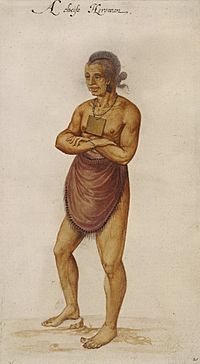Wingina facts for kids
Quick facts for kids
Wingina
|
|
|---|---|

Watercolor painting by John White c. 1585 of a man presumed to be Wingina
|
|
| Secotan leader | |
| Personal details | |
| Died | 1 June 1586 Dasamongueponke |
| Cause of death | Decapitation |
| Known for | First Native American leader to be encountered by English colonists in North America |
Wingina (born around the 16th century – died June 1, 1586), also known as Pemisapan, was an important leader of the Secotan people. He was a weroance, which means a chief or ruler. Wingina was the first Native American leader to meet English colonists in North America.
In the late 1500s, English explorers Philip Amadas and Arthur Barlowe visited the land where Wingina lived. They wrote about fights between Wingina's tribe, the Secotan, and another tribe called the Neusiok. When the English started to build a colony in the area, their relationship with the Secotan quickly became difficult. On June 1, 1586, Sir Ralph Lane led an attack on the Secotan. This attack was done to get more food for the new colony. Wingina was killed during this attack.
Contents
Wingina's Life and Leadership
Before the English built their first settlement on Roanoke Island, explorers Philip Amadas and Arthur Barlowe arrived. This was on April 27, 1584. They were sent by Walter Raleigh, who had permission from the English queen to start a colony. During their trip, Barlowe wrote detailed notes. He described conflicts and rivalries among different Native American groups.
Secotan and Neusiok Conflict
Wingina shared his tribe's history with Barlowe. He spoke about a neighboring tribe, the Neusiok, who lived near the Neuse River. Wingina called them the "Neiosioke." He explained that the Secotans had fought wars with the Neiosioke for many years. Some time before, Wingina had met with the Neiosioke king. They wanted to find a way to live peacefully together.
The two leaders planned a big feast for both groups. An unknown number of Secotan men and 30 women went to the feast in the town of Neiosioke. But the Neiosioke attacked the Secotans during the feast. By the time the fighting stopped, the Neiosioke had killed all the Secotan men. They only kept the women and children.
Meeting the English Explorers
When Wingina told this story to Barlowe, he saw a chance to help his people. Wingina and his people tried several times to convince the English to join them. They wanted to plan a surprise attack against the Neiosioke. The Englishmen were not sure if Wingina wanted revenge or if he truly liked them. So, they decided not to help the Secotans fight their rivals.
Instead, the English built a trusting relationship with the Secotans. Two Secotan chiefs, Manteo and Wanchese, showed this trust. They agreed to go back to England with Amadas and Barlowe.
Wingina's Impact and Legacy
Wingina's name and his land played a part in the naming of a famous place.
- The 1584 English expedition recorded the name of the local leader, Wingina. They told Queen Elizabeth I that he ruled a land called Wingandacoa. The Queen was likely influenced by this report. She changed the name of the colony to "Virginia". This name partly honored her as the "Virgin Queen." Virginia is the oldest English place-name in the United States that is not fully taken from a Native American word. It is also the fourth oldest English place-name still used today. However, on a later trip, Raleigh learned that Wingandacoa was a Carolina Algonquian phrase. It meant "What good clothes you wear!" It was not the actual name of Wingina's country.
- A United States Navy ship was named after him: USS Wingina (YTB-395).
- There is a street named Wingina Avenue in Manteo, North Carolina.
- A place called Wingina, Virginia also carries his name.
Images for kids
-
Watercolor painting by John White c. 1585 of a man presumed to be Wingina


